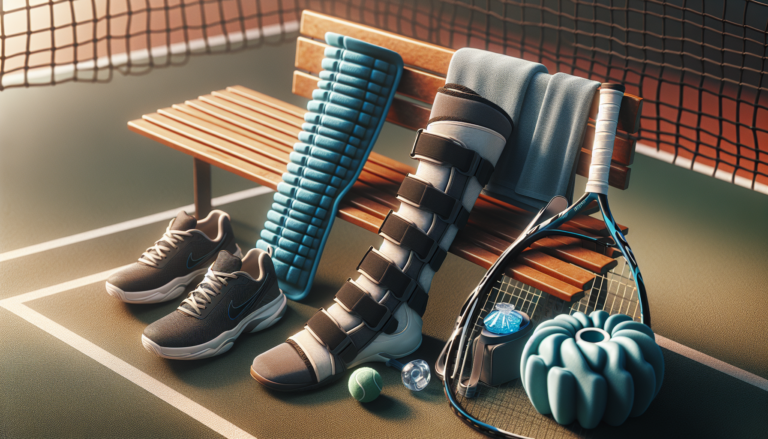Understanding Tennis Knee
Tennis knee, also known as jumper’s knee or patellar tendonitis, is a common injury among tennis players. It is characterized by pain and inflammation in the patellar tendon, which connects the kneecap to the shinbone. Tennis players are particularly susceptible to this condition due to the frequent jumping, quick movements, and sudden changes in direction required on the court.
What is Tennis Knee?
Tennis knee specifically refers to an overuse injury of the patellar tendon. This tendon plays a crucial role in extending the knee and enabling the powerful movements needed in tennis. When the tendon is subjected to repetitive stress and strain, it can become inflamed and painful.
The condition is often gradual in onset, with pain increasing over time. It may begin as a mild ache during or after playing tennis but can progress to more severe and constant pain if left untreated.
Common Symptoms of Tennis Knee
The primary symptom of tennis knee is pain located at the front of the knee, directly over the patellar tendon. Other common signs and symptoms include:
- Tenderness or pain when touching the patellar tendon
- Pain that worsens with activity, especially jumping or running
- Stiffness and difficulty fully straightening or bending the knee
- Swelling around the kneecap
- A feeling of weakness in the knee
Symptoms typically worsen with continued activity and improve with rest. In severe cases, pain may be present even at rest.
Causes of Tennis Knee
Several factors can contribute to the development of tennis knee in players:
Overuse and Repetitive Motion
The primary cause of tennis knee is overuse and repetitive strain on the patellar tendon. The explosive movements, jumping, and quick changes in direction in tennis put significant stress on the tendon. Over time, this can lead to small tears and inflammation.
Players who suddenly increase their training intensity or frequency without adequate rest are at higher risk. The patellar tendon needs time to adapt and recover from the stresses placed upon it.
Improper Technique
Using improper technique when hitting shots or moving on the court can place extra strain on the knee joint and patellar tendon. Examples include:
- Landing with the knees in a fully extended position after a serve or overhead
- Excessive knee flexion when lunging for shots
- Poor balance or instability in the legs during lateral movements
Repeatedly using incorrect form can overload the tendon and surrounding structures.
Inadequate Warm-Up
Failing to properly warm up the leg muscles and knee joint before playing can increase the risk of tennis knee. A good warm-up helps improve blood flow, flexibility, and prepares the body for the demands of the sport.
Tight quadriceps and hamstring muscles can put added strain on the patellar tendon. Gradually increasing intensity through a dynamic warm-up allows the muscles and tendons to loosen up and function optimally.
Prevention of Tennis Knee
While it may not be possible to completely eliminate the risk of tennis knee, several strategies can help prevent this condition:
Proper Warm-Up and Stretching
Incorporating a proper warm-up routine before playing is crucial. This should include dynamic stretches that target the quadriceps, hamstrings, and calf muscles. Examples include leg swings, lunges, and squats.
Spending 10-15 minutes warming up can significantly reduce the risk of injury. After playing, static stretching can help improve flexibility and prevent muscles from tightening up.
Strengthening Exercises
Strengthening the muscles around the knee joint can help support the patellar tendon and improve leg stability. Key exercises include:
- Quadriceps strengthening: Straight leg raises, wall squats, leg presses
- Hamstring curls
- Calf raises
- Hip abduction exercises
Incorporate these exercises 2-3 times per week, with rest days in between, to build strength gradually.
Using Correct Technique
Focusing on proper form and technique during tennis strokes and movements is important for injury prevention. Key areas to address include:
- Bending the knees and hips when landing from a jump
- Maintaining good knee alignment during lateral movements
- Using the legs efficiently to generate power, rather than overloading the upper body
Consider working with a tennis coach or sports physiotherapist to analyze and optimize your technique. Video analysis can provide helpful feedback.
Treatment for Tennis Knee
If tennis knee does develop, prompt treatment can speed up recovery and prevent the condition from worsening. Treatment options include:
Rest and Ice
The first step in treating tennis knee is to rest the affected leg and avoid activities that cause pain. Applying ice to the knee for 15-20 minutes several times a day can help reduce pain and inflammation.
Compression bandages or knee sleeves can provide support and minimize swelling. Elevating the leg above the heart when resting also aids in reducing inflammation.
Physical Therapy
A sports physiotherapist can design a rehabilitation program specific to your needs. This may include:
- Stretching exercises to improve flexibility
- Strengthening exercises for the leg muscles
- Manual therapy techniques like massage and joint mobilizations
- Recommendations for taping or bracing the knee
Physical therapy aims to restore normal knee function, address muscle imbalances, and gradually return to tennis.
Medications
Over-the-counter pain relievers like ibuprofen or naproxen can help manage pain and reduce inflammation. In some cases, doctors may recommend corticosteroid injections for more severe pain.
Always consult with a healthcare professional before starting any new medication regimen.
Surgical Options
Surgery is rarely needed for tennis knee, as most cases respond well to conservative treatment. However, if symptoms persist despite several months of nonsurgical treatment, surgical options may be considered.
Surgical procedures aim to repair damaged tendon tissue and remove any abnormal tissue growth. The specific type of surgery depends on the severity of the injury.
Rehabilitation and Recovery
Proper rehabilitation is key to recovering from tennis knee and preventing future recurrences.
Rehabilitation Exercises
A graduated exercise program is a core component of the recovery process. Initial exercises focus on improving flexibility and range of motion in the knee joint.
As pain subsides, strengthening exercises are introduced to rebuild muscle strength and endurance. Eccentric strengthening, which involves lengthening the muscle while it contracts, is particularly beneficial for the patellar tendon.
Exercises progress from simple movements to more functional and tennis-specific drills. This prepares the knee joint for the demands of returning to the court.
Gradual Return to Play
Returning to tennis too quickly can lead to re-injury. A gradual return to play protocol is essential.
This typically involves starting with light groundstrokes and gradually increasing intensity and duration. Plyometric exercises like jump rope and bounding help prepare the knee for the impact of tennis movements.
Pay attention to any pain or discomfort during the return to play process. If symptoms recur, back off and allow more time for healing.
Professional Tennis Players and Knee Injuries
Even at the highest levels of the sport, tennis players are not immune to knee injuries.
Case Study: Novak Djokovic
Tennis star Novak Djokovic faced a match exit and injury concerns during his match against Hurkacz. The highly competitive match highlighted the physical demands professional tennis players endure.
Despite Djokovic’s knee injury, he showcased his resilience and skill to secure the win. This example demonstrates that even top athletes must manage and overcome injuries to succeed.
Impact on Career and Performance
Knee injuries like tennis knee can significantly impact a professional player’s career. Missed tournaments, decreased performance, and a lengthy rehabilitation process are potential consequences.
In severe cases, chronic knee pain can shorten a player’s career. Seeking prompt treatment, following a structured recovery plan, and making technique modifications are crucial for minimizing the long-term impact of knee injuries.
Balancing training loads, cross-training, and scheduled rest periods can help professional players maintain knee health throughout their careers.






